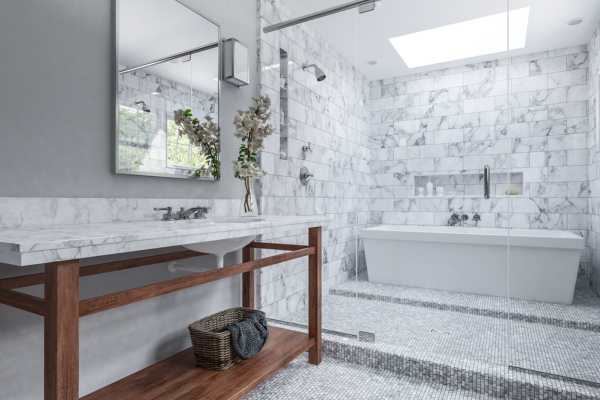Wetrooms design offers sanitary products that are necessary to design functional and practical bathing and utility rooms. At each stage of creating such an interior, it is necessary to use equipment and accessories related to water drainage systems, floor sealing and heating. These are also products that are functional, practical and characterised by a modern, fashionable style. Which sanitary accessories or materials should be taken into account when creating a wet room design?
- Shower tray in the implementation as a part of wetrooms design
- Wet room ideas – shower screens in big and small wet rooms
- Underfloor heating in wet rooms
- Linear drains
- Square drains in wetrooms
- Waterproofing and tiles in bathrooms
The implementation of the shower tray as a part of wetrooms design
One of the basic elements of wetrooms design equipment are wet room shower trays. The use of a shower tray is necessary in every such installation. It must be connected to the drainage system to efficiently drain water into the sewage system. These shower trays are waterproof and must have a slight slope to allow water to flow down the drain. A properly designed structure of such equipment protects the substrate against getting wet.
These products have standard shower tray sizes, but they can be adapted to the needs of a specific room. This is a solution that looks very good in a modernly designed shower area.
Wet room tray can be combined with shower screens to prevent water from splashing all over the room.
When choosing a shower tray for a large or small wet room, it is important to choose a model adapted to the requirements of concrete or wooden floors.
Shower trays create a waterproof base for a wet room floor in walk in showers, which can be covered with floor tiles (such as ceramic tiles) similar to those in the bathroom. In this way, design consistency and a harmonious appearance are maintained.
Wet room ideas – shower screens in big and small wet rooms
A shower screen in a shower room is a way to separate shower space from the rest of the bathroom. Such glass screens are mounted to the floor along the shower tray and to the walls.
This modern solution allows you to install the shower panel in such a way as to seal the floor and prevent water from getting onto the tiles outside the shower. Screens are most often made of tempered glass to make them resistant to impacts, damage, scratches and cracks. It is very important to match the length of the shower screen to the length of the shower tray and take into account its slope. This solution can be used in both small and large family bathroom.
Underfloor heating in wet rooms
Modern wet rooms also include underfloor heating, which increases the comfort of using the bathroom. Available models of such systems are resistant to moisture and water. They have different power and can be adjusted in size to the bathroom surface. Such sets are very thin and easy to assemble.
This solution can be used as an additional heating element. In a wet room, underfloor heating allows for faster removal of moisture, which often causes mould to form on the walls. It is very important to synchronise the underfloor heating system with the thermostat. This small device allows you to set heating parameters and adapt them to the needs of wet room users.
Linear drains
Wet room systems also require the selection of linear drains that are installed next to the shower. When choosing a drain, you should take into account the style of the designed bathroom and the length of the drain. You should also make sure that it has a matching channel membrane. The drain is an element that must match the type of shower tray, its height, floor finish, as well as other elements and materials used during the installation of individual parts of the bathing zone.
Square drains in wetrooms
It may turn out that in a specific shower model it is necessary to install square drains. Modern models are usually equipped with plastic siphons and an elegant cover. They are also adjustable. There are various grates to choose from in terms of their design, colour and size. They can be installed in a concrete or wooden base. An interesting addition to such an accessory is a hair catcher. It makes it easier to collect hair and then clean the drain, which stops clogging.
Waterproofing and tiles in bathrooms
In wetrooms, not only equipment elements are very important, but also the necessary materials that facilitate the installation of individual accessories, protect bathroom surfaces against moisture and enable aesthetic finishing of the interior.
When designing a wet room, you should consider purchasing waterproofing tapes, tile adhesive, and waterproof grout. Modern solutions include liquid coatings that protect substrates from absorbing water.
Currently, there are many accessories available on the market that allow you to design and finish a functional, safe and stylish bathroom. It is worth getting acquainted with new products that make work on the bathroom easier and more efficient.

 How to Generate your E-Shram Card? Apply Online
How to Generate your E-Shram Card? Apply Online The Impact of Advanced SEO Techniques on Online Visibility
The Impact of Advanced SEO Techniques on Online Visibility Emirates Multi-City Flights Are Cheaper or Not?
Emirates Multi-City Flights Are Cheaper or Not? What Makes FamiSafe A Perfect Choice For Your Child Safety
What Makes FamiSafe A Perfect Choice For Your Child Safety How Technology is Changing Long-Distance Moving
How Technology is Changing Long-Distance Moving The Role of Certifiers in Commercial Development
The Role of Certifiers in Commercial Development Fun88 รีวิวเว็บคาสิโนออนไลน์ ใบอนุญาต ฟีเจอร์เด่น พร้อมแชร์ทางเข้า Fun88แท้ อัพเดทใหม่
Fun88 รีวิวเว็บคาสิโนออนไลน์ ใบอนุญาต ฟีเจอร์เด่น พร้อมแชร์ทางเข้า Fun88แท้ อัพเดทใหม่ Everything You Need To Know About The Champions League Final
Everything You Need To Know About The Champions League Final